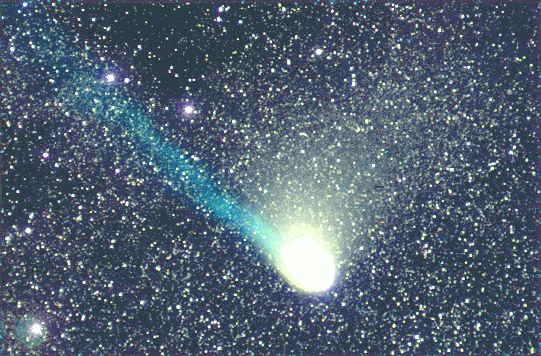Credit & Copyright: P. H. Mikuz and B. Dintinjana
(Crni Vrh Obs.,U. Ljubljana)
Explanation:
Comet Hale-Bopp has quite a tail to tell already.
This remarkable comet
was first discovered in 1995, even
before Comet Hyakutake. Since then,
this erupting snowball continues
to fall into our inner Solar System
and is starting to put on quite a show. Comets
have been known throughout history to show tails that spread across
the sky. In the above picture, the blue stream is the ion
tail
which consists of ions pushed away from the comet's head
by the solar wind.
The ion tail always points directly
away from the Sun. Comet Hale-Bopp
is now visible in the morning sky,
moving a few degrees each day. Comet Hale-Bopp
is expected to be at its best and brightest in late March and early April.
1999 2000 2001 2002 2003 2004 2005 2006 2007 2008 2009 2010 2011 2012 2013 2014 2015 2016 2017 2018 2019 2020 2021 2022 2023 2024 2025 |
Yanvar' Fevral' Mart Aprel' Mai Iyun' Iyul' Avgust Sentyabr' Oktyabr' Noyabr' Dekabr' |
NASA Web Site Statements, Warnings, and Disclaimers
NASA Official: Jay Norris. Specific rights apply.
A service of: LHEA at NASA / GSFC
& Michigan Tech. U.
|
Publikacii s klyuchevymi slovami:
tail - Comet Hale-Bopp - kometa Heila-Boppa - kometnye hvosty
Publikacii so slovami: tail - Comet Hale-Bopp - kometa Heila-Boppa - kometnye hvosty | |
Sm. takzhe:
Vse publikacii na tu zhe temu >> | |
